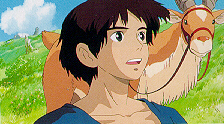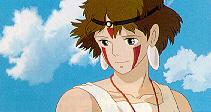The following are some notes and key passages from Susan Napier's
article in Positions 9:2 (Fall 2001), pp. 467-493). This document is
intended solely for the purpose of summarizing discussion held in class at Willamette
University and to underscore some of Professor Napier's key points. All of the
ideas and most of the wording are Professor Napier's and no one is attempting
to claim or represent otherwise. In some instances, quotation marks are used
for direct quotes but in other instances, direct wording from the article is
used without appropriate quotation marks. So please do not quote from this page
at all. Go directly to the original article. RPL
Confronting Master Narratives: History as Vision in Miyazaki
Hayao’s Cinema ofDe-assurance
by
Susan J. Napier
"Who speaks of the past?" (Rosenstone) With the advent of globalization,
national histories and national identities have become contested territories
as citizens in an increasingly interdependent world try to define themselves
against an oppressively homogenous global culture dominated by the U.S. In fact,
it is the mass entertainment industries—film, television, music and videos—that
increasingly take on the task of "speaking for the past."
In the 1950s and 1960s it was Kurosawa, with his humanistic jidaigeki, and Ozu
with his elegies to a vanishing past that offered visions of a past with room
for heroism and deep humanity which, though separate from the contemporary world,
resonated deeply in a Japan struggling to redefine itself after WWII. With the
rise of TV and the animation boom in the 1960s and 1970s, visions of Japan’s
past "became both fragmented and ideologically diverse."
In the U.S., one candidate for speakerhood is Walt Disney whose films often
distort history and culture but "function as mass cultural legitimations
of an essentially U.S. world view, one that is upbeat and centered on individual
action and initiative, and—while it acknowledges Otherness—often ends
up erasing difference through its joyously inclusive finales. . .[so] that it
is to function as a cinema of reassurance. . .which promotes a vision of a world
in which all problems are solved and harmony is restored under the aegis of
U.S. ideology and values." (469)"
Napier will offer "an example of a mass cultural alternative that offers
its own distinctive vision of the world, a vision that at times directly challenges
the thematics of reassurance of so much of U.S. cinema. The alternative is the
Japanese animation industry, whose products, usually called anime, embrace a
far wider continuum of approaches to culture, history, and national identity
in general than most of the products from the contemporary Hollywood film industry."
In contrast to most U.S. cartoons (at least until the recent success of The
Simpsons and South Park), anime texts offer a dark and complex view
of the world," (470)
Anime tend to feature tightly controlled narratives, psychological realism with
messages that are humanistic and emphasize such values as loyalty, friendship,
responsibility, and initiative. Though Miyazaki’s work has darker elements
than Disney films, much of his work can also be considered to negotiate an essentially
reassuring narrative structure.
Disney’s Alladin, Mulan, The Jungle Book all rely
on myths and stories from other cultures—but everyone winds up "performing
Americanness" in the end. In contrast, Miyazaki’s characters can never
be solely described as "performing Japaneseness." Instead, Miyazaki
creates characters considerably more independent in thought and action than
the group-oriented characteristics traditionally celebrated in Japanese culture.
Especially female characters who transcend traditional gender coding. Miyazaki’s
heroines are active, determined and independent v. the standard "dreamy,
nurturing, and ultimately passive heroines" of the shojo variety. E.g.

Nausicaa explores the apocalyptic wasteland collecting samples and performing
scientific experiments on her own. So she is a thinking, capable, creative,
independent woman.
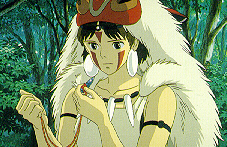
San, in Mononokehime, is a raging mixture of anger and aggression taking
on human civilization with the help of her wolf siblings. These heroines are
indebted to both Japanese and Western sources for their overall characterization,
unlike Disney’s more purely American protagonists. Miyazaki’s films
incoporate "a flexible openness and an appreciation of other cultures."
Therefore, they reinforce "a distinctly transnational message focusing
on human responsibility and the oneness of humans with nature and minimizing
distinctive racial or national characteristics." (475)
Nausicaa is a favorite family film in Japan. "In contrast…to
Disney’s dissemination of U.S. cultural attributes in exotic disguise,
Miyazaki’s work seemed comfortable in an equally exotic world where different
cultures and national identities playfully intermingled to offer audiences an
alternative to a sometimes oppressively defined national identity." (475-6)
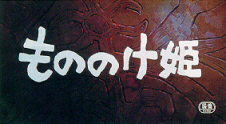
Mononokehime appears at first glance to be very different because it gives
a vision of Japanese culture and identity set in the 14th-15th century Muromachi
period. It also offers a vision of Japanese femininity which take into account
alternatives to the master narratives promoted after the Pacific War in Ministry
of Education textbooks. Offers a vision of cultural dissonance, spiritual loss,
and environmental apocalypse in which humans and nature battle each other and
women are major players. . .Overall, it suggests a theme of de-assurance."
Rather than provide a happy closure, the film ends on a note of uncertainty
and fear. (476-77)
Some Strategies:
1. few samurai, peasant or feudal lords appear. Instead it’s people and
kamigami who do not usually appear in history.
2. ahistorical because setting is nonhuman—liminal space.
3. focuses on Emishi a group of marginal people like the Ainu v. Yamato people.
Some of the characters Characters:
1. Ashitaka—young lord of Emishi who is cursed by a dying boar god. Discovers
two unusual places: the forest,and Tatara, a weapons manufacturing site.

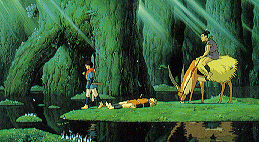
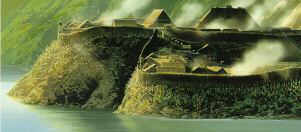
2. Tatara is in league with Yamato Court v. forest gods
3. Tatara is govered by lady Eboshi who has created a refuge for outcast women
and lepers.
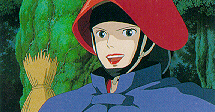

4. San, the "possessed princess," by the fearsome spirits of nature.
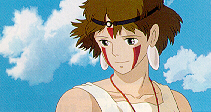
In climactic battle, Eboshi cuts off the head of the shishigami which
causes destruction of the forest. Eboshi is supposed to deliver head to the
court but San and Ashitaka seize it and return it to the shishigami.
Ashitaka is willing to work with the penitent Eboshi but San cannot forgive
humans for killing shishigami whom Ashitaka is convinced still lives. So this
is a fantasy dressed as historical fiction.
Miyazaki undermines female stereotypes with Eboshi, San and Moro. No one is
cute here.
Eboshi is a leader who cares for the sick and the outcast, but is also a military
person focused on the destruction of the shishigami.
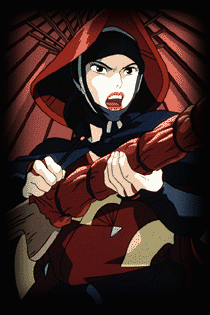
Moro appears as a wise and brave mother but she is also a ferocious killer.
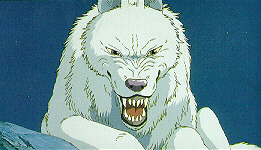
San is shown as a ruthless figure of unrelenting violence. Her animal furs,
blood-smeared face and her fierce demeanor associate San with both violence
and nature. But also strong element of a primordial, sexual, female as well.
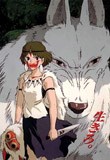
Wildness and primitive sexuality make her otherness not only female, but also
bestial. She has aggressive, terrifying intensity. So she is destabilizing .
So these 3 female characters defamiliarize what otherwise might be hackneyed
film roles. Moro could’ve been male for example.
Eboshi is a female who can both destroy and rebuild so facile stereotyping of
technology/armaments/industrialized culture as evil is problematized. "Eboshi’s
character thus defamiliarizes the standard notions of both historical femininity
and industrialzed culture." (484)
"Second major destabilizing strategy of the film is the use of the fantastic
and uncanny to align nonhumans and nature with the supernatural. . .Princess
Mononoke’s use of fantasy is clearly to disturb our notions of reality."
(484) e.g., the forest is wild and threatening v. Disney’s taming of the
jungle to make it happy and friendly. "Mononoke insists on difference;
Tarzan attempts to erase it." Tarzan privileges an anthropocentric
view of the world while animals in Mononokehime are violently antihuman.
Nothing innocent about nature here; it is not cozy or comfortable. Rather it
is remotely beautiful, potentially threatening. "This is also a world in
which technology cannot be erased or ignored." (488) Moroever, whole notion
of Japanese national identity is problematized. The film ends with the "paradoxical
combination of stunning visual imagery and a bleak environmental message."
A vivid warning about ecological disaster. In Nausicaa, "in the
end the heroine is reborn and strides across the sky in a field of gold, offering
a message of unification and hope to both humans and giant insects who populate
her thirtieth-century dystopia." In Mononokehime, "the scene
of budding flowers and new green grass at the film’s end pastes a rather
forced upbeat visual closure over the brilliantly evoked scenes of environmental
apocalypse shown only moments before." (489)
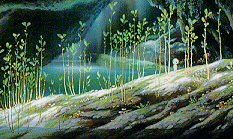
San and Ashitaka have to agree to live apart, in different worlds, like the
pluralities so many of us face in our lives.
